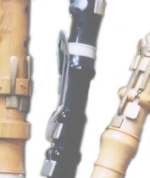 |
Giuseppe Maria Cambini (1746–after 1818)Giuseppe Maria Cambini (1746 - c. 1825) was probably born in Livorno. After that the details of his his life become even more sketchy. In his autobiography Cambini relates the story of a journey to Napoli (around 1767), where indeed, he may have made his debut. At this point the yarn becomes decidedly more lurid: he claims to have been captured by pirates, sold as a slave, and finally redeemed by a rich Venetian merchant in Spain.
In any case, at some point he moved to Paris, where he played at the Concert Spirituel in May 1773. Incidently his death is also shrouded in obscurity and may have been as early as 1818 (in a poor house, or possibly as a result of something more sinister.) He was both popular and prolific, and amongst his many works for winds are included at least 28 Symphonies Concertantes. This form was particularly popular in France, and had a deep influence on his wind quintets. Unfortunately today Cambini is remembered foremost as the catalyst behind the loss of Wolfgang Amadeus Mozart's Sinfonia Concertante (K297b) for flute, oboe, horn, bassoon and orchestra during the 1778 season of the Concert Spirituel. Prompted by Cambini, the concert director Joseph Le Gros cancelled a performance of Mozart's sinfonia and substituted a work of Cambini's for the same combination. Mozart's work has never resurfaced. Cambini prospered - his works were performed by the Concert Spirituel and the Concert des Amateurs; he became composer of the Royal Chapel, then in 1788 the music director of the Théâtre des Beaujolais - which was closed in 1791 - and finally director of the Théâtre des Louvois till the 1794, when the theatre became bankrupt. While many other foreign artists did not adapt themselves to the new revolutionary regime, Cambini seemed to fit in seamlessly; he composed patriotic hymns and songs for which the Education Committee paid 2000 livres. After 1800 he took up musical criticism: he wrote for the Allgemeine Musikalische Zeitung (1803-1805) and for the Parisian magazine Les tablettes de Polymnie (1810-1811). This is the last definite information we have about his life. There are two hypothesis about the date and place of his death: some believe he died in the mental hospital of Bicêtre on December 29th 1825. Others believe that he died in the Netherlands in 1818. Cambini published his set of Trois Quintetti Concertans for flûte, hautbois, clarinette, cor et bassoon in Paris in 1802 and dedicated them to the clarinetist, Jean Xavier Lefèvre. Together the works constitute the first known set of quintets for a set of five single wind instruments to be composed after the seminal Eb Major Quintet of c. 1780 (for flute, oboe, clarinet, dalie [cor anglais], and bassoon) by Franz Anton Rosetti (1746-1792), Cambini's contemporary. These are ambitious wind quintets, remarkably so given that they are the earliest known examples composed for the now standard combination of flute, oboe, clarinet, horn, and bassoon. So who played with the clarinetist Jean Xavier Lefèvre in the first performances? Possibly his colleagues at the Paris Conservatoire and Opéra, the oboist Antoine Sallantin; the hand horn player, Frédéric Duvernoy; and the bassoonist, François-René Gebauer. Each of the three quintets is structurally unique: Quintet No 1 is inspired by the structure of the Sinfonia Concertante, Quintet No. 2 is a study in Sonata Form, and Quintet No. 3 also takes Sonata Form as the basis of the first two movements, but concludes with a Rondo. All three works demonstrate that Cambini was very comfortable with the possibilties of the five wind instruments for which he composed. The works are light-hearted and classical in spirit, but their form points firmly forward; they bridge the past and the future, fusing classical style with a romantic sound world. |